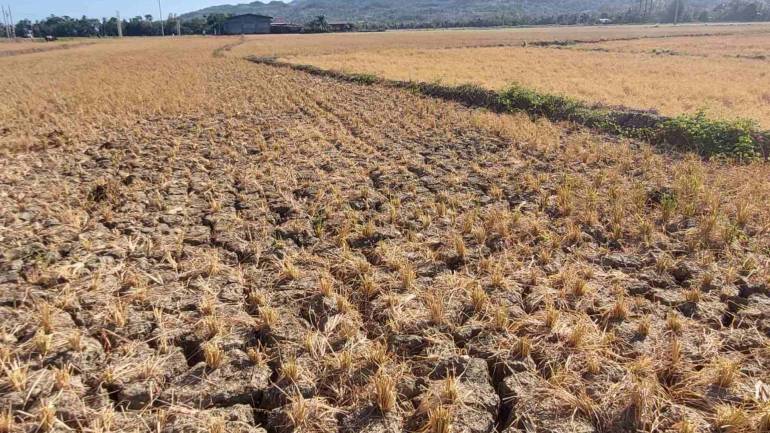Philippines farmers pray for help as they hurt from El Niño

“In 44 years of our farming, this is the first time experience where from what used to be 500 rice bags harvest from planting on 3 hectares, and earning 1 million last year from 3 hectares planted on onions, we are 101 percent bankrupt.” Lucy Rondael
Lucy Rondael, 68, joins hundreds of farmers in the coastal town of Bulalacao in southern Luzon, Philippines, to voice complaints about the farm losses caused by the severe drought resulting from the El Nino phenomenon.
She stated that they had been praying for help.
“In 44 years of farming, this is the first time we have gone from what used to be 500 rice bags harvest from planting on 3 hectares to earning 1 million last year from 3 hectares planted on onions. We are 101 percent bankrupt,” said Rondael in a phone conversation on Monday, March 4, and in an exchange of messages and emails."
Her home town is the first in the country to have declared a state of calamity because of a severe drought due to El Nino, according to municipal agriculture officer Rommel de Guzman.
The declaration allows local governments to use emergency funds to help constituents who need assistance.
Bulalacao is a third-class agricultural municipality with a population of nearly 70,000.
The drought damaged 325 hectares of onion and 539 hectares of rice, resulting in estimated losses of P87 million.
575 farmers cultivate onions on at least 500 ha of land, while 545 farmers plant rice on 539 ha, according to municipality figures. Twenty-eight farmers are involved in cultivating at least 20.2 ha reserved for other farm products, including vegetables.
According to the Department of Agriculture, the drought has also affected other parts of the country, amounting to hundreds of millions in losses and affecting thousands of farmers in regions like Ilocos, Mimaropa (Mindoro, Marinduque, Romblon, and Palawan), Western Visayas, and the Zamboanga Peninsula.
“We urgently need financial assistance for daily expenses, or we might be forced to stop sending students to school if we cannot pay our debts incurred for farm expenses. If possible, we wish the financial assistance to be given individually,” said Rondael.
The Bulalacao Information Office stated in an email exchange that the drought dries up rivers, the municipality's main source of water, leaving thirsty farmlands. It has already had an impact on the quality and quantity of paddy and onion production.
The Philippine Atmospheric, Geophysical and Astronomical Administration (PAG-ASA) said “mature El Niño is expected to continue and show signs of weakening” but will likely persist up to June.
Farmer Marciano Ausan, 53, is a resident of Barangay Poblacion in Bulalacao. He projects that the drought might persist until July because June is the transition between dry and rainy days.
He plants papaya and onions in nearby villages, such as Nasukob. “I have been a farmer since birth. This is the toughest drought we are experiencing. On the five hectares where I planted paddy, there is no grain. It is droughty here. Water is very difficult to get,” he said in Filipino.
His wife Marivic, 55, said in a phone conversation on March 4 that they are still sending their two children to college, one in Mindoro and the other in Batangas.
“We are asking the government for help. Our papayas and onions are covered by crop insurance. We hope to be given good services and benefits,” said Marciano.
"Like, we spent P300,000 on two hectares, still excluding labor expenses. Heat is extreme; worms and insects come out, so farmers find ways, like by using insecticides and pesticides,” said Marivic.
Unlike the others, who are dependent on paddy and onion for livelihood, the couple has vegetables and livestock like carabao and goats.
Rondael and Ausan share the same sentiments. “Many of us are losing hope because we have spent a lot. Members ask, What will our lives be like? We are lacking in food, and we can’t pay our debts. How will we be able to borrow money again?”
Agencies come for assistance
Bulalacao Mayor Ernilo C. Villas and Municipal Agriculture Officer Rommel De Guzman have teamed up with the Department of Agriculture (DA) to provide assistance.
On February 27, DA undersecretaries Jerome V. Oliveros and Arnel V. De Mesa visited Bulalacao, where they met with 50 heads of farmers’ groups at the Real Five Hotel.
The meeting included Rondael, president of the 68-member Bulalacao Sustainable Agriculture Farmers Association.
Oliveros said the DA will give 11 million worth of solar-powered water irrigation to Barangay Cambunang and Maujao, seven million pesos worth of solar-powered water irrigation to Barangay Nasukob, and cold storage for onions worth 40 million pesos to Bulalacao.
Each farmer can apply for a loan under Programming Sure Aid, amounting to P25,000 for each registered farmer. Each insured farmer can claim a maximum of P20,000 in insurance.
The DA Quick Response After Recovery Program will provide impacted farmers with seedlings, fertilizer, and even live stock. Nine hundred twenty-seven registered farmers in Bulalacao will also get rice Farmer Financial Assistance worth P5,000 and P3,000 Fuel Assistance.
The Department of Social Welfare and Development (DSWD) will give food packs to affected farmers, and the Department of Labor and Employment has its TUPAD, or community-based package of assistance, that provides emergency employment. The National Irrigation Agency will also lend its support to those looking to dig for water sources.
The municipal agriculture office will issue the list of requirements and determine when farmers can avail of the loan and insurance, said the Bulalacao Information Office in a statement.








